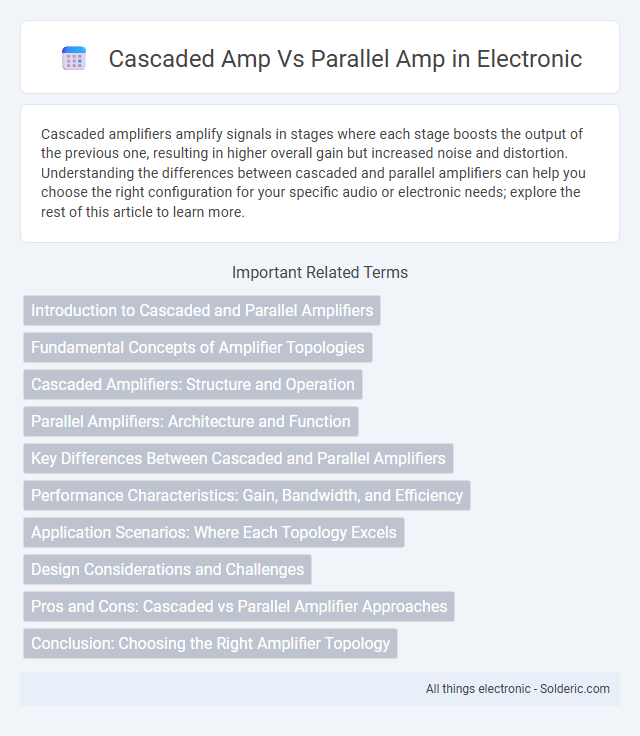Cascaded amplifiers amplify signals in stages where each stage boosts the output of the previous one, resulting in higher overall gain but increased noise and distortion. Understanding the differences between cascaded and parallel amplifiers can help you choose the right configuration for your specific audio or electronic needs; explore the rest of this article to learn more.
Comparison Table
| Feature | Cascaded Amplifier | Parallel Amplifier |
|---|---|---|
| Configuration | Amplifiers connected in series (output of one feeds input of next) | Amplifiers connected side-by-side sharing the same input and output signals |
| Gain | Multiplicative gain through stages (total gain = product of individual gains) | Gain remains similar to a single amplifier but power handling increases |
| Power Handling | Limited by the final stage | Increased power handling by splitting load across amplifiers |
| Noise | Noise figure increases with each stage | Noise figure similar to single amplifier stage |
| Linearity | May degrade with cascaded stages unless linearization techniques used | Improved linearity due to distributed amplification |
| Complexity | Moderate complexity with impedance matching between stages | Higher complexity due to combining networks and phase matching |
| Applications | Low-noise amplification, RF frontends | High power transmission, transmitter power amplifiers |
Introduction to Cascaded and Parallel Amplifiers
Cascaded amplifiers connect multiple amplifier stages sequentially, increasing overall gain while maintaining signal integrity through controlled impedance matching. Parallel amplifiers operate by splitting the input signal into multiple paths, amplifying simultaneously, and then combining outputs to enhance power handling and reduce distortion. Understanding the structural differences between cascaded and parallel amplifiers is crucial for optimizing performance parameters like gain, bandwidth, and linearity in RF and audio applications.
Fundamental Concepts of Amplifier Topologies
Cascaded amplifiers connect multiple gain stages in series, increasing overall gain by sequentially amplifying the signal, while parallel amplifiers split the input signal across multiple stages that operate simultaneously to enhance power handling and reduce noise. Cascaded topology emphasizes voltage gain and linearity by leveraging the cumulative effect of each stage, whereas parallel topology focuses on current gain and bandwidth improvement by distributing the load among amplifiers. Understanding these fundamental concepts aids in selecting suitable amplifier designs for applications requiring high gain or efficient power delivery.
Cascaded Amplifiers: Structure and Operation
Cascaded amplifiers consist of multiple amplifier stages connected in series, where the output of one stage feeds directly into the input of the next. This structure enhances overall gain by multiplying the individual gains of each stage while maintaining signal integrity through impedance matching. The operation relies on controlling the frequency response and minimizing noise accumulation, making cascaded designs suitable for high-gain applications in communication and signal processing systems.
Parallel Amplifiers: Architecture and Function
Parallel amplifiers feature multiple amplifier units operating simultaneously and combining their outputs to increase overall power without significantly amplifying distortion or noise. This architecture improves thermal management and reliability by distributing the load across several devices functioning in unison. The parallel configuration is commonly used in RF and audio systems to achieve higher output power while maintaining signal integrity.
Key Differences Between Cascaded and Parallel Amplifiers
Cascaded amplifiers connect multiple amplifier stages in series, enhancing overall gain by sequential signal amplification, while parallel amplifiers split the input signal across multiple amplifiers to increase power handling and reduce noise. Cascaded configurations typically offer higher gain but may suffer from increased distortion and bandwidth limitations, whereas parallel setups improve linearity and thermal management with potentially lower gain per path. Design choice depends on performance requirements such as gain, noise figure, power efficiency, and application-specific constraints.
Performance Characteristics: Gain, Bandwidth, and Efficiency
Cascaded amplifiers typically offer higher overall gain by sequentially amplifying the signal through multiple stages, but this can limit bandwidth due to cumulative frequency response roll-offs. Parallel amplifiers maintain broader bandwidth by dividing the input signal among multiple identical amplifier units working simultaneously, resulting in improved linearity and thermal management that enhances efficiency. Your choice depends on whether gain or wide bandwidth and efficiency are the primary performance priorities for your application.
Application Scenarios: Where Each Topology Excels
Cascaded amplifier topologies excel in applications requiring high gain and improved signal-to-noise ratio, such as radio receivers and long-distance communication systems. Parallel amplifiers are ideal for scenarios demanding high output power and efficiency, including audio power amplification and RF power transmission. Your choice depends on whether signal integrity or power handling is the primary concern in your specific use case.
Design Considerations and Challenges
Cascaded amplifiers require careful impedance matching and gain staging to minimize noise figure and distortion, making their design complex but efficient for achieving high overall gain. Parallel amplifiers offer improved linearity and power handling by distributing the input signal across multiple amplifier paths, yet balancing phase and amplitude among branches presents significant design challenges. Your choice depends on specific application requirements, balancing complexity, performance, and thermal management constraints.
Pros and Cons: Cascaded vs Parallel Amplifier Approaches
Cascaded amplifiers provide high overall gain by stacking multiple amplifier stages, but they can suffer from increased noise figure and potential signal distortion due to cumulative nonlinearities. Parallel amplifiers improve linearity and reduce distortion by distributing the input signal across multiple identical amplifier paths, enhancing power handling and efficiency, yet they require complex matching networks and can increase system size and cost. Choosing between cascaded and parallel amplifier designs depends on the trade-offs between gain, noise performance, linearity, power efficiency, and implementation complexity specific to the application.
Conclusion: Choosing the Right Amplifier Topology
Cascaded amplifiers offer higher overall gain by stacking multiple amplifier stages, making them ideal for applications requiring strong signal amplification with controlled noise levels. Parallel amplifiers excel in improving linearity and reducing distortion by sharing the input signal across multiple amplifier units, beneficial in high-fidelity audio and communication systems. Selecting the right amplifier topology depends on balancing gain requirements, linearity, power consumption, and noise performance to meet specific application demands.
Cascaded amp vs Parallel amp Infographic

 solderic.com
solderic.com